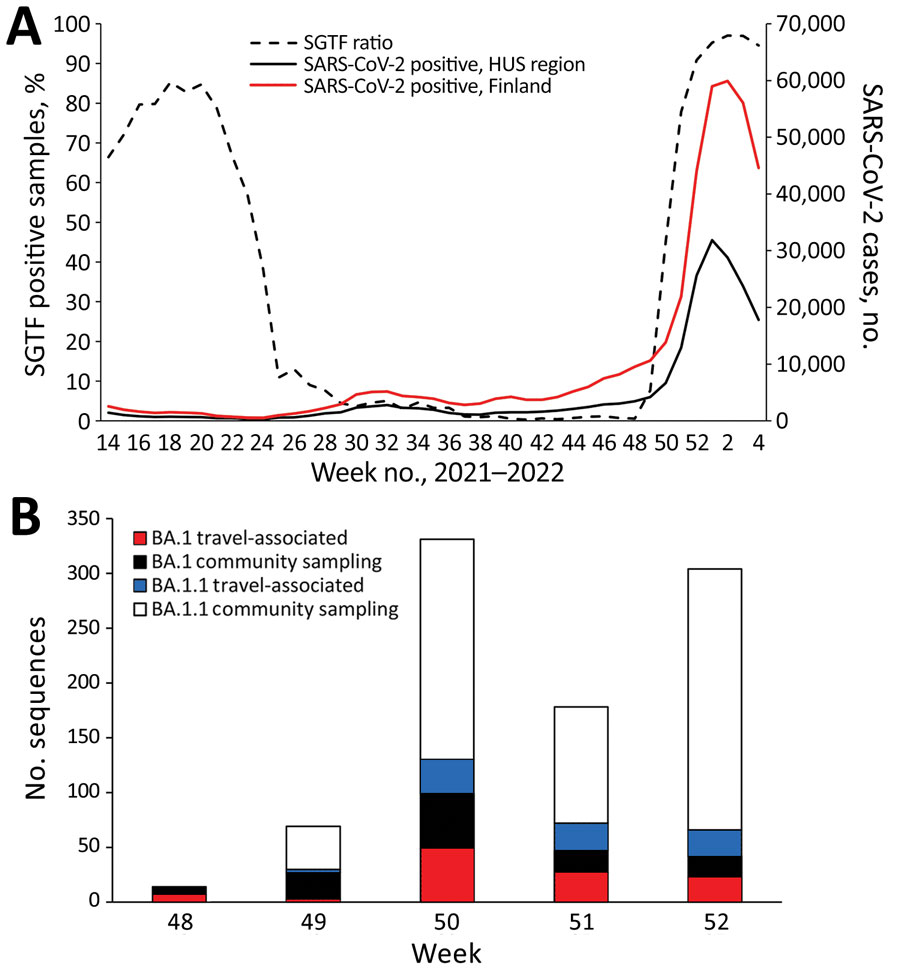Introduction and Rapid Spread of SARS-CoV-2 Omicron Variant and Dynamics of BA.1 and BA.1.1 Sublineages, Finland, December 2021
Hanna Vauhkonen

, Phuoc Truong Nguyen, Ravi Kant, Ilja Plyusnin, Mert Erdin, Satu Kurkela, Hanna Liimatainen, Niina Ikonen, Soile Blomqvist, Kirsi Liitsola, Erika Lindh, Otto Helve, Hanna Jarva, Raisa Loginov, Aino Palva, Tiina Hannunen, Sari Hannula, Mikko Parry, Paula Kauppi, Antti Vaheri, Tarja Sironen, Maija Lappalainen, Carita Savolainen-Kopra, Teemu Smura, and Olli Vapalahti

Author affiliations: University of Helsinki, Helsinki, Finland (H. Vauhkonen, P. Truong Nguyen, R. Kant, I. Plyusnin, M. Erdin, A. Vaheri, T. Sironen, T. Smura, O. Vapalahti); University of Helsinki and Helsinki University Hospital, Uusimaa, Finland (S. Kurkela, H. Liimatainen, R. Loginov, M. Parry, P. Kauppi, M. Lappalainen, T. Smura, O. Vapalahti); Finnish Institute for Health and Welfare (THL), Helsinki (N. Ikonen, S. Blomqvist, K. Liitsola, E. Lindh, O. Helve, C. Savolainen-Kopra); Institute for Molecular Medicine Finland (FIMM), Helsinki (A. Palva, T. Hannunen, S. Hannula)
Main Article
Figure 1

Figure 1. Introduction and spread of SARS-CoV-2 Omicron variant in Finland in late 2021–early 2022. A) Confirmed SARS-CoV-2 positives in Finland (red) and in the HUS region (black) and the proportion of SGTF measured by reverse transcription PCR–positive cases analyzed by the HUS Clinical Microbiology division (dashed line) from week 14 in 2021 through week 4 in 2022 (National Infectious Disease Registry, https://www.thl.fi/ttr/gen/rpt/tilastot.html). B) Weekly numbers of travel-associated and community sampling–derived Omicron cases (Pango lineages BA.1 and BA.1.1) for weeks 48–52, 2021. Travel-associated status was defined by either being sampled at a border or a patient record indicating most likely country of infection abroad. The lower amount of sequences obtained for week 51 originates most likely from the Christmas holiday season. Week 52 was the last full week of our study period. HUS, Helsinki and Uusimaa Hospital District; SGTF, S-gene target failure
Main Article
Page created: March 31, 2022
Page updated: May 22, 2022
Page reviewed: May 22, 2022
The conclusions, findings, and opinions expressed by authors contributing to this journal do not necessarily reflect the official position of the U.S. Department of Health and Human Services, the Public Health Service, the Centers for Disease Control and Prevention, or the authors' affiliated institutions. Use of trade names is for identification only and does not imply endorsement by any of the groups named above.
